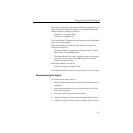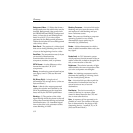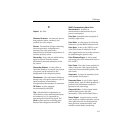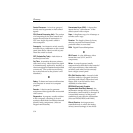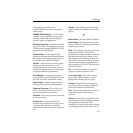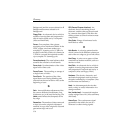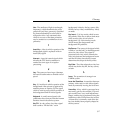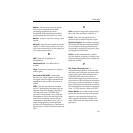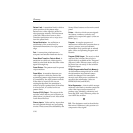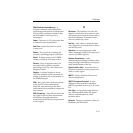
Glossary
G-7
Hue: The attribute of light (wavelength,
frequency) which determines the color
perceived (red, blue, green etc). Specified
by phase relationship to color burst in
composite video. Any saturated color
which is not one of the three primaries
may be treated as a combination of two
primaries.
I
Insert Key: A key in which a portion of the
background signal is replaced with an
insert (fill) signal.
Interrupt: A special control signal which
informs the CPU that its attention is
needed for some type of exception
processing.
J
Jog: The process of moving a videotape
forward or backward at a variable rate of
speed.
K
Key: (1) An effect in which a portion of the
background video picture is replaced by
another picture or caption (2) The signal
which is used to pass or block portions of
the background and fill video signals.
Keyboard: A small control panel with
pushbutton keys that provides the human
interface into an electronics system.
Key Fill: In a key effect, the video signal
that is said to “fill the hole” cut in
background video by the key source. Key
fill may be key video, modified key video,
or matte.
Key Invert: (1) A key mode which inverts
the polarity of the key to allow dark areas
of the source video to cut holes in
background. (2) A chroma key mode
which inverts the foreground and
background fill positions.
Key Source: The source of the signal which
is said to “cut the hole” in the background
scene for a key effect. This signal is
processed into a key which controls the
video mix between the background scene
and the fill video; thus the key source
determines the shape of the key effect.
Key Video: The video selected on a key bus
which may be the key fill, the key source,
or both.
L
Learn: The operation of storage in an
E-MEM system.
Lever Arm Transition: A transition between
primary video and/or title video signals
made by manually moving the lever arm.
Linear Key: A key which is processed at or
near unity gain by the switcher. Clip and
gain control have very small adjustment
ranges, and keying is performed using the
luminance values of the linear key source.
A Linear Key is normally used when the
key has already been properly shaped at
the key source.



